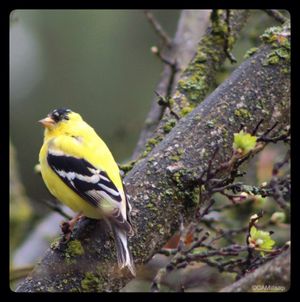A Little Bird Told Me
On the surface, attraction seems to be mysterious and hard to predict. What is it exactly that takes, puts them together two individuals and makes them into a couple? It’s surely something deeper than superficial appearances and it has to more than some random spark of sexual chemistry. So what draws us to the mate we choose?
Apparently, according to the book I’m reading, it’s all in the voice.
She speaks. He listens. He speaks. She listens. They get closer. Then comes a little preening, a little flirting and before anyone is fully aware of what’s happening, it’s just a short hop to building a nest, hungry little mouths to feed and the constant juggling of daily chores and endless live-or-die decisions.
This is probably the time to point out I’m reading a book about backyard birds of the Northwest, and the writer was describing the courting rituals of male and female goldfinches, but it seems to me the process is not dissimilar to the route most of us take when we find “the one.”
The writer, Bob Waldon, addressing the mating habits of the male goldfinch in Feeding Winter Birds in the Pacific Northwest, writes, “He bonds to his mate by learning the notes of her song and playing them back to her.” To paraphrase: She sings, he sings, they sing. And then it’s down to business.
The goldfinch, the official bird of Washington State, is a tiny bird who feeds on thistle and sunflower seeds. The goldfinch is a social bird that likes the company of the flock and their unique flight signature—the dip and soar as the fly— is lovely to watch as they move from tree to tree. The sunflower and thistle seeds Goldfinches prefer aren't available until late summer so they breed later than most other birds.
But when it’s time to settle down, goldfinches cut to the chase. Time is short. The male has to find the right voice in a chorus of chittering, singing female birds. And they do. They find a mate, build a nest, feed their young, and then the former individuals work as a couple to survive in an unpredictable and dangerous world. And all this based on her reaction to a shared song.
I don’t know why I’ve latched onto this bit of information, birds have so many ways of attracting and selecting a mate—but I think it’s because it reaches into the heart of so many human couples I know. Men and women who secretly feel their words are lost in a noisy world, unheard by even the head on the pillow beside them. Who doesn’t know a couple who is struggling on some level?
In winter, after the seeds are gone and, on a normal year, the snow blankets the fields, goldfinches forage greedily at backyard feeders. Now, in in the grey and often bleak days of early March, my feeders have been busy. As I work I listen to the calls and songs of the goldfinches and wonder who, in a few months, will be listening to whom.
